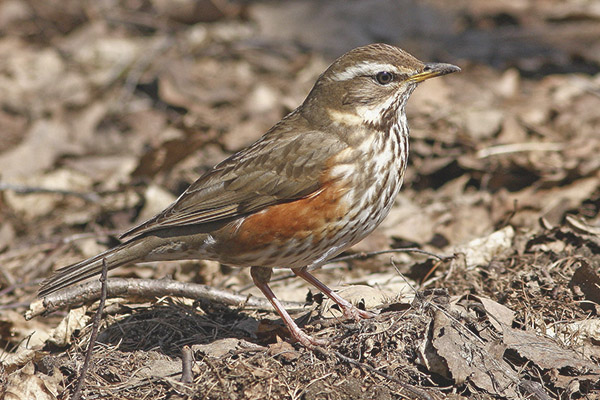The content of the article
Belobrovik is an elegant songbird. This species belongs to the family of thrushes. This bird got its name due to the light strip above the eyes.
Appearance
The main distinguishing feature of the species is the band above the eye. The plumage on the back is brown with a greenish tinge, and the lower part of the body is covered with light speckled plumage.
Coloring females somewhat paler. Their beak is small, has a sharp tip. Paws are small, dark. Small sharp claws on fingertips.
The wings of the belobrovik are also small, pointed. Wingspan - up to 35 cm. This species is the smallest in size among all thrushes. The body in length can reach 17-22 cm, the weight of an adult bird is 50-60 g.
Lifestyle
The bird is actively moving, flies easily.When moving on the ground, jumps or walks in steps. When he sees danger, he takes off. Particular caution is shown in the period of nest arrangement. They have them on the branching of trunks or on stumps. Sometimes the nest can be found in shrubs and even in the grass. Usually a bird can fly from place to place, but not during the nesting period. At this time, the birds do not fly away; they can only leave for a watering place.
When the nesting period ends, gather in flocks or fly alone, wandering through the forests to find food. Even if the white-browed man flies alone and finds a large amount of food, he will call his fellows with a cry. Looking for food on the surface of the earth. They do not stay for the winter, but fly away only late in the autumn if they have enough food. Fly in large flocks, sometimes with other thrushes.
Males learn to sing more chicks when they are under one month old. The sound is creaking. When they grow up, the singing becomes much more beautiful. The male sings near the nest during the entire period of nesting until the middle of summer. The first part of their song is a loud whistle, and the second is a tirade of different sounds.The male sings, usually at the top of the tree. He can also report danger with the help of alarming cries, or that he sees food. In this case, the bird uses a special calling sound.
Lifespan
It is known that representatives of this species in captivity can live for about 10 years. When kept at home individuals live to 20 years.
Where belobrovik lives
This bird lives on the territory of Eurasia, choosing deciduous and sometimes mixed forests. Favorite habitat for them is the birch forest. Belobroviki love to settle near the edges. You can meet them in the city park, in the forest belt. Representatives of the species choose a place so that there is a pond nearby.
Avoid coniferous forests, as well as too thick and dark. Wintering is carried out in northern Africa, southern Europe. Some of them fly to Asia Minor.
Nutrition
These birds are looking for food on the ground. They eat various insects, worms. They feed offspring with the same food. They eat large quantities of insect pests that harm forest trees.Including those that live under the bark, as well as larvae. Sometimes their diet includes arachnids, beetles, slugs.
Belobrovik also consumes food of plant origin. These are buds, seeds of plants. A special delicacy for them is wild berries. They eat the berries themselves, and their seeds. Depending on the period, they eat strawberries and raspberries, then - ripe currants. Birds can also be seen in the gardens, as they love to feast on gooseberries and cherries.
Enemies in nature
The main threat to the white-browed are various birds and mammals that ruin nests by eating chicks and eggs. Among the animals it can be squirrels or martens. Among birds, ravens and jays pose a threat. Larger predators can attack adult belobrovik. These may be foxes, which may well attack the nest.
A very large number of eggs die in the period of early nesting, when the crowns of the trees are not yet covered with foliage. At this time, it is very easy for predators to see a nest in a tree. If the white-browed man locates his nest near the person, dogs or cats can harm him.Hazards are more exposed to those nests that are located on the ground. They can be attacked by cats or dogs.
Breeding
Mass nesting occurs in the second half of April or early May. A nest can be either on a tree or on a stump or shrub. But in any case, the bird does not build it too high.
They build it from small dried twigs, roots, grass stalks and leaves. All this material holds clay or just earth. The nest is shaped like a bowl. Birds are trying to disguise him as best as possible in order to save them from predators.
The nursing period of the belobrovik lasts about 2 weeks. They hatch them together with the male alternately. In one laying there are 3-6 eggs. In color, they are gray with a bluish tinge, covered with brown specks.
View status
This species is very numerous. According to various data belobrovikov there are 6-50 million pairs. Therefore, today the disappearance does not threaten them. But in European countries, species are observed to prevent the threat of a decrease in the number of the species.
Video: whitebird (Turdus iliacus)













To send